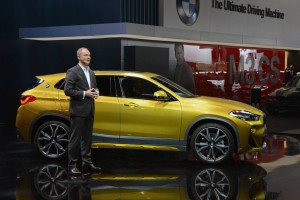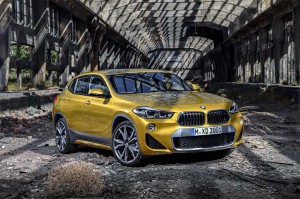
Bernard Kuhnt, president and CEO of BMW North America, won't be making an appearance at the next NAIAS.
BMW has become the latest automaker to announce it won’t have a presence during the next North American International Auto Show in Detroit.
The announcement comes barely a month after German rival Mercedes-Benz announced it was pulling out of what had long been considered the industry’s most important U.S. auto show, at least from a media preview perspective. A number of other brands had already been no-shows during the January 2018 NAIAS, including Jaguar/Land Rover, Volvo and Mazda, leading organizers of the annual event to start looking at their options.
“This decision (to pull out) was made as BMW Group is constantly examining our presence at trade-shows and other engagements, while, at the same time, also exploring alternative platforms and formats,” the automaker said in a statement. “The overall goal is to communicate our ideas and plans regarding future mobility in the best way and achieve the greatest possible visibility for our products, technologies and innovations.”
Faced with the possibility even more manufacturers could defect, the Detroit Auto Dealers Association, which runs the show, has begun to look at options. The DADA last month confirmed it was considering a move to October, an option widely hailed as it would avoid staging the NAIAS during some of the coldest weeks of the year – and a time that did little to show off the ongoing resurgence of the City of Detroit.
(Mercedes-Benz dropping out of 2019 NAIAS. Click Here to find out why.)

BMW's new X2 M Sport model is the last vehicle the company will debut in Detroit for the next two years.
Observers weren’t surprised by the move. “A lot of us would like to avoid Detroit,” said a senior planner at a major Asian brand who asked not to be identified by name.
On the plus side, he acknowledged, the NAIAS has traditionally brought in more journalists from around the world than any other North American auto show. But there are a number of challenges facing auto shows, in general, and the NAIAS, in particular.
Broadly, carmakers now see more options available than the traditional route of unveiling a new product at an auto show. These include private, one-brand events as well as events like the late-summer Pebble Beach Concours and the Consumer Electronics Show in Las Vegas. CES typically runs a week before Detroit and has turned into a showcase not only for TVs and smartphones but for the high-tech automobiles the industry is launching in ever-increasing numbers.
Detroit has a number of specific challenges:
- With strict union rules, participants have long complained, costs are extraordinarily high. Simply plugging in an extension cord can require hiring a crew for a half-day;
- The weather in January is typically bleak, something neither journalists nor industry executives appreciate, though public attendance still runs north of 700,000 during most years;
- Detroit is home to the Big Three domestic automakers and while some import brands have gained traction, others question the need to display in a market where they have low sales.
Throughout the years, the NAIAS has seen some manufacturers drop out of the media preview but remain on the show floor for the consumer side of the show. But neither Mercedes and BMW will have a presence in any form come January 2019.
“All auto shows — even Detroit — have to prove that they can bring in the consumers, which will ultimately justify the high costs incurred in order to participate,” said Jessica Caldwell, an analyst with data tracking service Edmunds.
(Click Here for more about the possibility of NAIAS moving to October.)
Whatever the reason, the number of new model previews at this year’s show barely topped two dozen, down from a peak of more than 70 during the early years of the NAIAS which was the name chosen in 1989 when a regional Detroit Auto Show transformed itself into an international powerhouse.
DADA officials have made it clear they aren’t going to let the NAIAS fade away without a fight.
“A critical part of being a sought-after global stage for companies is that we continuously evaluate future opportunities to make sure our show meets participating brands’ needs,” DADA spokesman Max Muncey told TheDetroitBureau.com earlier this month. “We are exploring many opportunities for the show, with October being one of those opportunities. Ongoing discussions are underway with key stakeholders around the world.”
Along with the possible move to October, DADA President Rod Alberts has confirmed that even a name change might be in the works.
For the NAIAS it isn’t all bad news, however. Mercedes, for one, indicated it would reconsider Its decision post-2019. Though it’s not clear if the German carmaker signaled to organizers that a move to October would be more appealing, Mercedes this year staged a major event at CES that cut into its presence in the Motor City.
In years past, some automakers have gone and then come back, notably Nissan which returned a few years ago after a three-year absence.
And while many premium luxury brands have been no-shows in recent years, the NAIAS was able to lure back some, including Rolls-Royce, by scheduling a sort of mini auto show, dubbed the Gallery, an invitation-only event specifically targeting the most affluent of the Detroit area’s buyers.
(For a complete round-up of 2018 NAIAS debuts, Click Here.)
“It’s time for auto shows to make an adjustment,” Alberts told TheDetroitBureau.com during an interview earlier this year. That includes adding more niche events, including The Gallery and Automobili-D, the latter a sort of mini-CES focused on high-tech topics like autonomous and electrified vehicles now transforming the global auto industry.

Two issues:
1) Another case of the unions killing the Golden Goose;
2) DADA stubbornly staying with the mid-January date. We live here and don’t like it, what do you think a guy from Germany or Japan thinks? At least we have the nightlife.
Is this move by BMW and Mercedes because Tesla does not show up in the auto show and yet Tesla sold more of its Model S vehicles than the luxury vehicles of its class from BMW & Mercedes in Germany itself? May Mercedes and BMW want to follow the same marketing channels as that of Tesla.
Tesla’s marketing is a truly peculiar approach that, I don’t believe, anyone will directly follow. I think there are plenty of other reasons, per the story, why BMW and MB pulled out.
Paul E.
I think it’s all those issues and more:
a. unions
b. weather
c. timing
d. cheaper alternatives
e. market reach